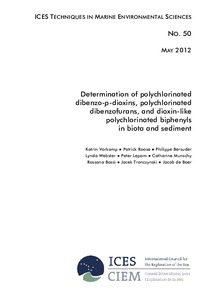| dc.contributor.author | Vorkamp, Katrin | |
| dc.contributor.author | Roose, Patrick | |
| dc.contributor.author | Bersuder, Philippe | |
| dc.contributor.author | Webster, Lynda | |
| dc.contributor.author | Lepom, Peter | |
| dc.contributor.author | Munschy, Catherine | |
| dc.contributor.author | Bossi, Rossana | |
| dc.contributor.author | Tronczynski, Jacek | |
| dc.contributor.author | de Boer, Jacob | |
| dc.date.accessioned | 2019-01-16T00:11:45Z | |
| dc.date.available | 2019-01-16T00:11:45Z | |
| dc.date.issued | 2012 | |
| dc.identifier.citation | Vorkamp, K.; Roose, P.; Bersuder, P.; Webster, L.; Lepom, P.; Munschy, C.; Bossi, R.; Tronczynski, J., and de Boer, J. (2012) Determination of polychlorinated dibenzo‐p‐ dioxins, polychlorinated dibenzofurans, and dioxin‐like polychlorinated biphenyls in biota and sediment. ICES Techniques in Marine Environmental Sciences No. 50. 23 pp. DOI: http://dx.doi.org/10.25607/OBP-260 | en_US |
| dc.identifier.issn | 0903–2606 | |
| dc.identifier.uri | http://hdl.handle.net/11329/703 | |
| dc.identifier.uri | http://dx.doi.org/10.25607/OBP-260 | |
| dc.description.abstract | Polychlorinated dibenzo‐p‐dioxins, polychlorinated dibenzofurans (PCDD/Fs) and polychlorinated biphenyls (PCBs) are environmental contaminants regulated by the Stockholm Convention of Persistent Organic Pollutants. Being hydrophobic and lipophilic, these compounds accumulate in the marine environment in sediments and lipid‐rich tissue of marine organisms, making these matrices preferred media for environmental monitoring. This document focuses on the analysis of PCDD/Fs and dioxin‐like PCBs (i.e. non‐ortho and mono‐ortho PCBs), which have a similar planar molecular structure to PCDD/Fs and, therefore, exhibit similar toxic effects. Because concentrations in the environment are low and common analytical methods result in co‐extractions of a large variety of potentially interfering compounds, analytical procedures are complex. This document includes comments and advice on sampling and sample pretreatment steps, suitable extraction and clean‐up procedures as well as preconcentration methods. It highlights the importance of extract clean‐up and the risk of contamination. Furthermore, suitable methods for instrumental analysis are discussed for gas chromatographic separation, compound identification, and quantification and detection methods. Although high‐resolution mass spectrometry often is the method of choice, low‐resolution mass spectrometry can also provide sufficiently sensitive analyses, in particular for screening purposes. In this context, bioassays can also play a role, reflecting a cumulative toxicity rather than concentrations of individual congeners. The paper also discusses general aspects of good laboratory practice, quality assurance/quality control, and laboratory safety. | en_US |
| dc.language.iso | en | en_US |
| dc.publisher | International Council for the Exploration of the Sea (ICES) | en_US |
| dc.relation.ispartofseries | ICES Techniques in Marine Environmental Sciences; 50 | |
| dc.title | Determination of polychlorinated dibenzo-p-dioxins, polychlorinated dibenzofurans, and dioxin-like polychlorinated biphenyls in biota and sediment. | en_US |
| dc.type | Report | en_US |
| dc.description.status | Published | en_US |
| dc.format.pages | 23pp. | en_US |
| dc.description.refereed | Refereed | en_US |
| dc.publisher.place | Copenhagen, Denmark | en_US |
| dc.description.currentstatus | Current | en_US |
| dc.description.sdg | 14.1 | |
| dc.description.bptype | Standard Operating Procedure | en_US |
| dc.description.bptype | Guide | en_US |
| obps.contact.contactemail | info@ices.dk | |
| obps.resourceurl.publisher | http://ices.dk/publications/library/ | en_US |
 Repository of community practices in Ocean Research, Applications and Data/Information Management
Repository of community practices in Ocean Research, Applications and Data/Information Management
